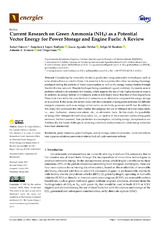Mostrar el registro sencillo del ítem
Current research on Green Ammonia (NH3) as a potential vector energy for power storage and engine fuels: a review
| dc.contributor.author | Estevez, Rafael | |
| dc.contributor.author | López Tenllado, Francisco Javier | |
| dc.contributor.author | Aguado-Deblas, Laura | |
| dc.contributor.author | Bautista, Felipa M. | |
| dc.contributor.author | Romero, Antonio A. | |
| dc.contributor.author | Luna, Diego | |
| dc.date.accessioned | 2023-07-18T10:14:18Z | |
| dc.date.available | 2023-07-18T10:14:18Z | |
| dc.date.issued | 2023 | |
| dc.identifier.issn | 1996-1073 | |
| dc.identifier.uri | http://hdl.handle.net/10396/25769 | |
| dc.description.abstract | Considering the renewable electricity production using sustainable technologies, such as solar photovoltaics or wind turbines, it is essential to have systems that allow for storing the energy produced during the periods of lower consumption as well as the energy transportation through the distribution network. Despite hydrogen being considered a good candidate, it presents several problems related to its extremely low density, which requires the use of very high pressures to store it. In addition, its energy density in volumetric terms is still clearly lower than that of most liquid fuels. These facts have led to the consideration of ammonia as an alternative compound for energy storage or as a carrier. In this sense, this review deals with the evaluation of using green ammonia for different energetic purposes, such as an energy carrier vector, an electricity generator and E-fuel. In addition, this study has addressed the latest studies that propose the use of nitrogen-derived compounds, i.e., urea, hydrazine, ammonium nitrate, etc., as alternative fuels. In this study, the possibility of using other nitrogen-derived compounds, i.e., an update of the ecosystem surrounding green ammonia, has been assessed, from production to consumption, including storage, transportation, etc. Additionally, the future challenges in achieving a technical and economically viable energy transition have been determined. | es_ES |
| dc.format.mimetype | application/pdf | es_ES |
| dc.language.iso | spa | es_ES |
| dc.publisher | MDPI | es_ES |
| dc.rights | https://creativecommons.org/licenses/by/4.0/ | es_ES |
| dc.source | Energies, 16(14), 5451 (2023) | es_ES |
| dc.subject | Green ammonia | es_ES |
| dc.subject | Green hydrogen | es_ES |
| dc.subject | Power storage | es_ES |
| dc.subject | Ammonia economy | es_ES |
| dc.subject | Water electrolysis | es_ES |
| dc.subject | Urea aqueous solutions | es_ES |
| dc.subject | Ammonium nitrate | es_ES |
| dc.subject | Fuel cell | es_ES |
| dc.subject | Solar ammonia refinery | es_ES |
| dc.title | Current research on Green Ammonia (NH3) as a potential vector energy for power storage and engine fuels: a review | es_ES |
| dc.type | info:eu-repo/semantics/article | es_ES |
| dc.relation.publisherversion | https://doi.org/10.3390/en16145451 | es_ES |
| dc.relation.projectID | Gobierno de España. PID2019-104953RB-I00 | es_ES |
| dc.relation.projectID | Gobierno de España. TED2021-132224B-I00 | es_ES |
| dc.relation.projectID | Gobierno de España. MCIN/AEI10.13039/501100011033 | es_ES |
| dc.relation.projectID | Junta de Andalucía. P18-RT-4822 | es_ES |
| dc.rights.accessRights | info:eu-repo/semantics/openAccess | es_ES |

